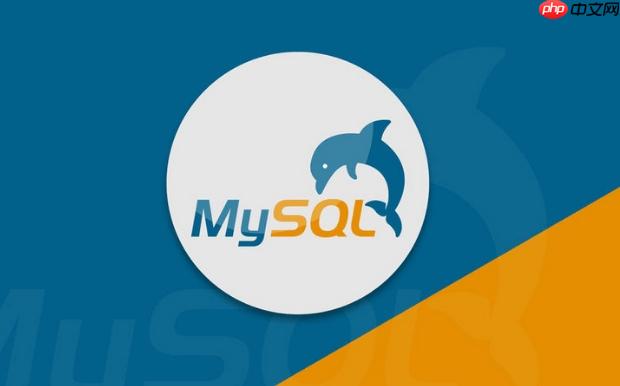答案:mysql数据去重可通过DISTINCT查询、临时表、窗口函数或delete JOIN实现,选择方法需考虑数据量、版本及性能;使用etl工具可简化复杂清洗流程。

在MySQL中实现数据去重,核心在于找出并移除重复记录。这通常涉及编写特定的SQL查询语句,并根据去重的策略选择适当的方法,例如使用
DISTINCT
关键字进行简单查询,或者通过创建临时表、使用窗口函数等更复杂的方式来处理。清理重复数据则可能需要结合
DELETE
语句和
JOIN
操作,确保只保留一份数据。
解决方案:
-
使用DISTINCT关键字查询去重数据:
这是最简单的去重方式,适用于只需要查看去重后的结果,而不需要修改表结构的情况。
SELECT DISTINCT column1, column2, ... FROM table_name;
例如,要从
users
表中查询不同的
email
地址:
SELECT DISTINCT email FROM users;
这种方法的局限在于,如果
table_name
表中存在多个列,
DISTINCT
会返回所有列的唯一组合,而不是单个列的去重。
-
创建临时表去重:
这种方法适用于需要永久性地删除重复数据的情况。首先创建一个临时表,将去重后的数据插入到临时表中,然后删除原表,并将临时表重命名为原表。
CREATE TEMPORARY TABLE temp_table AS SELECT min(id) as id, column1, column2, ... FROM table_name GROUP BY column1, column2, ...; DELETE FROM table_name; INSERT INTO table_name SELECT * FROM temp_table; DROP TEMPORARY TABLE temp_table;
这里
min(id)
用于选择保留的记录,假设
id
是主键且唯一。
GROUP BY
子句用于将具有相同
column1, column2, ...
值的记录分组。
-
使用窗口函数去重(MySQL 8.0+):
MySQL 8.0引入了窗口函数,可以更灵活地进行数据去重。
DELETE FROM table_name WHERE id IN ( SELECT id FROM ( SELECT id, ROW_NUMBER() OVER (PARTITION BY column1, column2, ... ORDER BY id) as row_num FROM table_name ) as t WHERE row_num > 1 );
这个查询使用
ROW_NUMBER()
窗口函数为每个分组的记录分配一个序号。
PARTITION BY
子句指定分组的列,
ORDER BY
子句指定排序的列。然后,删除
row_num
大于1的记录,即重复的记录。需要注意的是,由于MySQL的限制,需要将子查询的结果作为一个临时表来处理。
-
直接使用DELETE JOIN语句去重:
这种方法避免了创建临时表,直接使用
DELETE
语句和
JOIN
操作删除重复数据。
DELETE t1 FROM table_name t1 INNER JOIN table_name t2 ON t1.column1 = t2.column1 AND t1.column2 = t2.column2 AND t1.id > t2.id;
这个查询将表
table_name
与自身连接,条件是
column1
和
column2
的值相同,并且
t1.id
大于
t2.id
,这意味着
t1
是重复的记录。然后,删除
t1
中的记录。
如何选择合适的去重方法?性能考量与最佳实践
选择哪种去重方法取决于多个因素,包括数据量、表结构、MySQL版本以及对性能的要求。
- 对于小数据量,
DISTINCT
关键字可能足够简单高效。
- 对于中等数据量,创建临时表可能是一个不错的选择,但需要注意磁盘空间的使用。
- 对于大数据量,窗口函数(MySQL 8.0+)或
DELETE JOIN
语句可能更有效,因为它们可以利用索引来提高查询速度。但是,这些方法也可能需要更多的CPU资源。
最佳实践包括:
- 在执行任何去重操作之前,务必备份数据。
- 在测试环境中验证去重操作的正确性。
- 根据实际情况选择合适的去重方法。
- 定期维护数据库,包括清理不再需要的数据。
如何在去重过程中避免误删数据?常见错误与防范措施
去重过程中最常见的错误是误删数据。这通常发生在以下情况下:
- 没有正确理解去重的条件。
- 使用了错误的SQL查询语句。
- 没有备份数据。
为了避免误删数据,可以采取以下措施:
- 仔细分析去重的需求,明确哪些记录是重复的。
- 编写SQL查询语句时,务必进行充分的测试。
- 在执行任何去重操作之前,务必备份数据。
- 可以使用事务来确保去重操作的原子性。如果去重过程中发生错误,可以回滚事务,避免数据损坏。
例如,在使用
DELETE JOIN
语句去重时,务必确保
ON
子句中的条件正确地定义了重复的记录。否则,可能会误删不应该删除的记录。
除了sql语句,还有其他去重方案吗?ETL工具与数据清洗流程
除了SQL语句,还可以使用ETL(Extract, transform, Load)工具来进行数据去重。ETL工具通常提供图形化界面,可以更方便地定义数据清洗流程。
常见的ETL工具包括:
- apache NiFi
- Talend
- Informatica PowerCenter
使用ETL工具进行数据去重的流程通常包括以下步骤:
- 数据抽取: 从MySQL数据库中抽取需要去重的数据。
- 数据转换: 使用ETL工具提供的转换功能,例如去重、过滤、转换等,对数据进行清洗。
- 数据加载: 将清洗后的数据加载到MySQL数据库中。
ETL工具的优点在于可以简化数据清洗流程,提高效率。但是,使用ETL工具需要一定的学习成本。此外,ETL工具可能需要额外的硬件资源。
总之,选择哪种去重方案取决于实际情况。如果只需要简单地去重,可以使用SQL语句。如果需要进行更复杂的数据清洗,可以使用ETL工具。


评论(已关闭)
评论已关闭